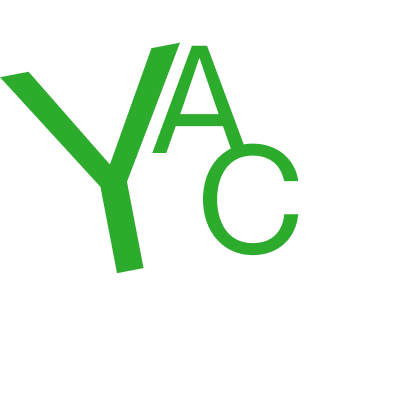Charlotte Dawson
Interview by David McLeavy
-
Published in April 2022
-
I want to start by asking where your interest in sculpture, and more specifically the objects, signs and symbols that surround us, comes from? Has it been something you have been interested in ever since your time studying at Norwich University of the Arts?
I think sculpture is something I've always been interested in because I've always treasured and collected objects. I don't collect in any regimented way because I collect objects that may not have any established prior relationships. Which I guess sums up my practice as a whole, and why my methods and subjects differ from work to work. I'm drawn to objects that don't have an intentional connection that comes from their intended purposes, but that happens because of human connections. Which is a concept that underpins my entire practice. It's something that as an artist I explore but ultimately that other people provide me with. Sometimes the objects I approach have a more universal blurring of lines, like in my most recent work Here/There, the plate is an object that is more understood as having many different purposes imposed by those who treasure and use them. Whereas some other objects or materials may have more hidden relationships or relationships to specific groups of people or personal connections. University gave me the opportunity to understand the application of objects past my own parameters. To try and understand the uses of objects as a way of preservation and remembrance with the capability to supplant a lived experience with a physical marker.
I am interested in the difference between what objects may interest you and what objects you think might interest the majority of other people.. How much of your work is about your own personal preferences and how much is informed by what objects and materials you think other people, such as your audiences, will have a relationship with?
Because I often work with objects and materials that are already known to the vast majority of people, I think my consideration of the other in my work comes earlier on in the production. So by the point of exhibiting work I already feel like some people will be able to connect with the pieces. Through the production of the artwork I’ve already been exploring the connections that people have with the original object. For instance in Here/There I'm exploring the variety of connections that plates can hold, past their function and into sentimentality, souvenir status, commemoration and alternative uses. Because I work so often with collections and multiples, I feel the freedom to explore within my work, things that are both personal to me and things that are outside of myself. Some creative choices may be more personal but I still feel that they are also universal as well, because I'm working with something that others have already built relationships with. In some sense, even if my intentions and my personal connections aren't received by everyone who views the work. The commonality of the materials allows for some assurance that the viewer will be able to forge their own understanding.
It's interesting because other people actually play a big part at the beginning of my work, like I've said I work with materials that surround us. So there also has to be some change or something that makes me focus on those objects and more often than not that's the presence of someone else. Artworks that I've produced, like Under-side, Under-stood which depict concrete marker posts, have more of a tangled relationship to an idea of space, language and the presence of another. It took the physical disturbing of ground through roadworks for me to focus on that space, from another person exposing that environment to me. Sometimes even the textures I use in certain pieces are those borrowed from something I've observed as a design choice by someone else.
I am glad that you mentioned your work Under-side, Under-stood as what intrigued me by this work is that it was presented entirely online, due to early restrictions as a result of the pandemic. As your work has a very particular focus on texture and material, how do you feel presenting your work online changed the way audiences experienced the exhibition. Did you have to make any decisions in regards to the layout of the work considering it would be explored through the screen.
I think Under-side, Under-stood having to be presented wholly digitally posed some interesting challenges but also in some ways made some elements of curation easier. As a whole, artists have to consider how their work will be seen through the multiple ways that people view art. For the longevity of a piece, documentation is key. When you curate an ‘in person’ exhibition you have to balance the physical experience of seeing the work in person, with how well the work will suit photographic documentation. When I was curating Under-side, Under-stood I had a day in the gallery that I had given myself before leaving the studios because of the impending lockdown. So, my curatorial process had to be very decisive and quick and entirely for the camera. Which in many ways was easier, I moved the pieces to suit the composition of photographs rather than the experience of a viewer. Each piece is intended to be experienced in the round but they also have a front and a back which would have made positioning them for viewers quite challenging, trying out all the variations of groupings and positionings. It seems natural in a photo that everything should point towards the camera. Maybe less so in an exhibition that each sculpture should face the viewer from the moment they enter a space.
The surface details of each piece are very important to the experience. But I guess in some way, when touch is restricted already, the main purpose of those details was for them to be noticed and in photographing the pieces myself I could have some control over the fact that they would be. Having that control as the artist has its downsides because I can only focus on the elements that I believe are of interest and as the person who created the pieces, it's impossible to create a degree of separation between me and the work. But it also meant that I felt no element of the pieces or exhibition was overlooked, when everything is presented digitally then maybe people can reach their own readings from the documentation, as they would when everything is presented physically. I also think that because I knew no one was going to see the work for the first time in person, it pushed me to be more generous with sharing my process as well as finished pieces.
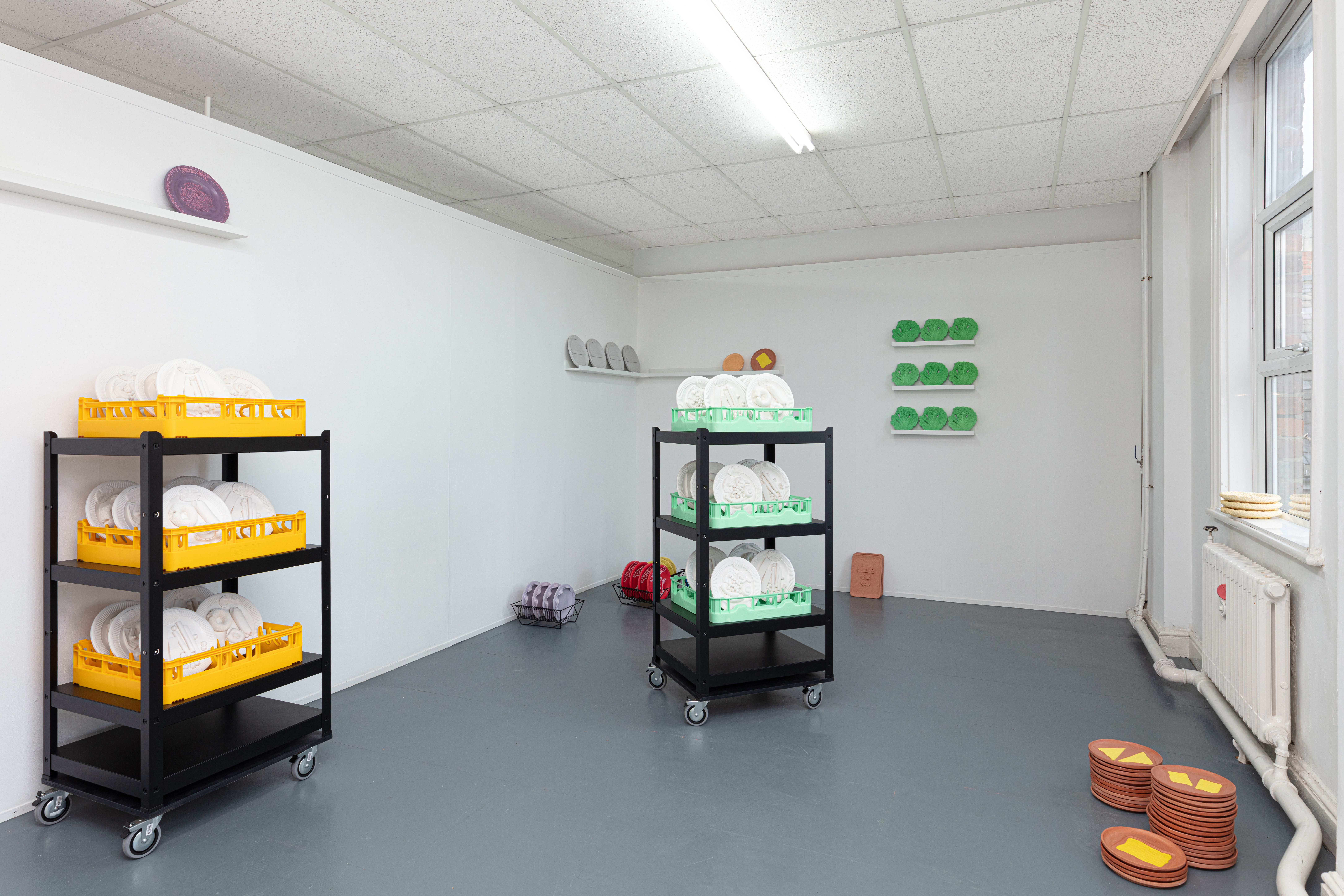
Here/There, installation view, Abingdon Studios, Blackpool, 2022. Image by Matt J Wilkinson
We are chatting at an interesting point for you in that your new body of work which we mentioned earlier, Here/There, is being presented at Abingdon Studios in Blackpool, before being adapted for an exhibition at Bloc Projects in Sheffield. Before we talk about that body of work in particular, I am interested to know how your approach to presenting and building solo exhibitions of your work may have changed over the last few years. This is your 3rd and 4th solo exhibition, after presenting at Airspace, Stoke-on-Trent and S1 Artspace, Sheffield. Have you had to consider how one body of work leads into the next, or are you happy to keep experimenting from exhibition to exhibition at this point?
There's definitely a similarity that I feel has carried through my solo exhibitions. Often in the actual approach to producing work for exhibiting. In all of my solo exhibitions to date, I've made pieces in some form of residency, with the intention of exhibiting the work as a form of installation. Instead of producing a solo exhibition that contains what I would view as multiple distinct pieces, that might show a breadth of my practice, I've produced artworks that are realised once exhibited. These artworks have also come about because of an extended time in residence, either with a gallery like Airspace or Abingdon Studios in my most recent work. Or like in the case of my exhibition at S1 Artspace, pieces that were produced through a self-driven residency approach. I created the pieces at York St John University with the help of the AA2A Scheme and during that making period the opportunity to exhibit at S1Artspace as a studio holder arose. So, I began working towards an artwork that could inhabit the gallery space as a whole.
I can see the ties between those shows not only in the process of developing them but also in material connections. There's a link from the first solo at Airspace and my recent solos at Abingdon Studios and Bloc Projects. I was interested in the industrial heritage of Stoke-on-Trent and focused on plates to symbolise that industry. During that exhibition I skirted around that particular object which I guess I've also done in this recent work. But at Airspace I used fragments of ceramics, and cast concrete in Plate moulds to form the tops of bollards. In my recent solo exhibitions, I'm representing plates but with alternative material and imagery. Then at S1 Artspace I refocused on the imagery of street furniture. I can see where the first of my solos has influenced the subsequent exhibitions and how much ideas of industry tie those works together.
One thing that I believe may have changed from my most recent experience working on my exhibition Here/There for Blackpool and Sheffield is the idea of longevity. I've come to realise there's an interesting process in repurposing artwork for exhibitions past just one presentation of the work. I think it's interesting to consider an alteration that can occur with the artworks. To actually pay attention to that process of re-exhibiting and let that influence and add layers to the pieces instead of aiming to replicate one thing. To actually say there's something that's happened to the work past its production and one way of curating and if this goes to another location how do I represent that. Is there an opportunity to reimagine work in a way that pays attention to the context that we're now seeing the work in.
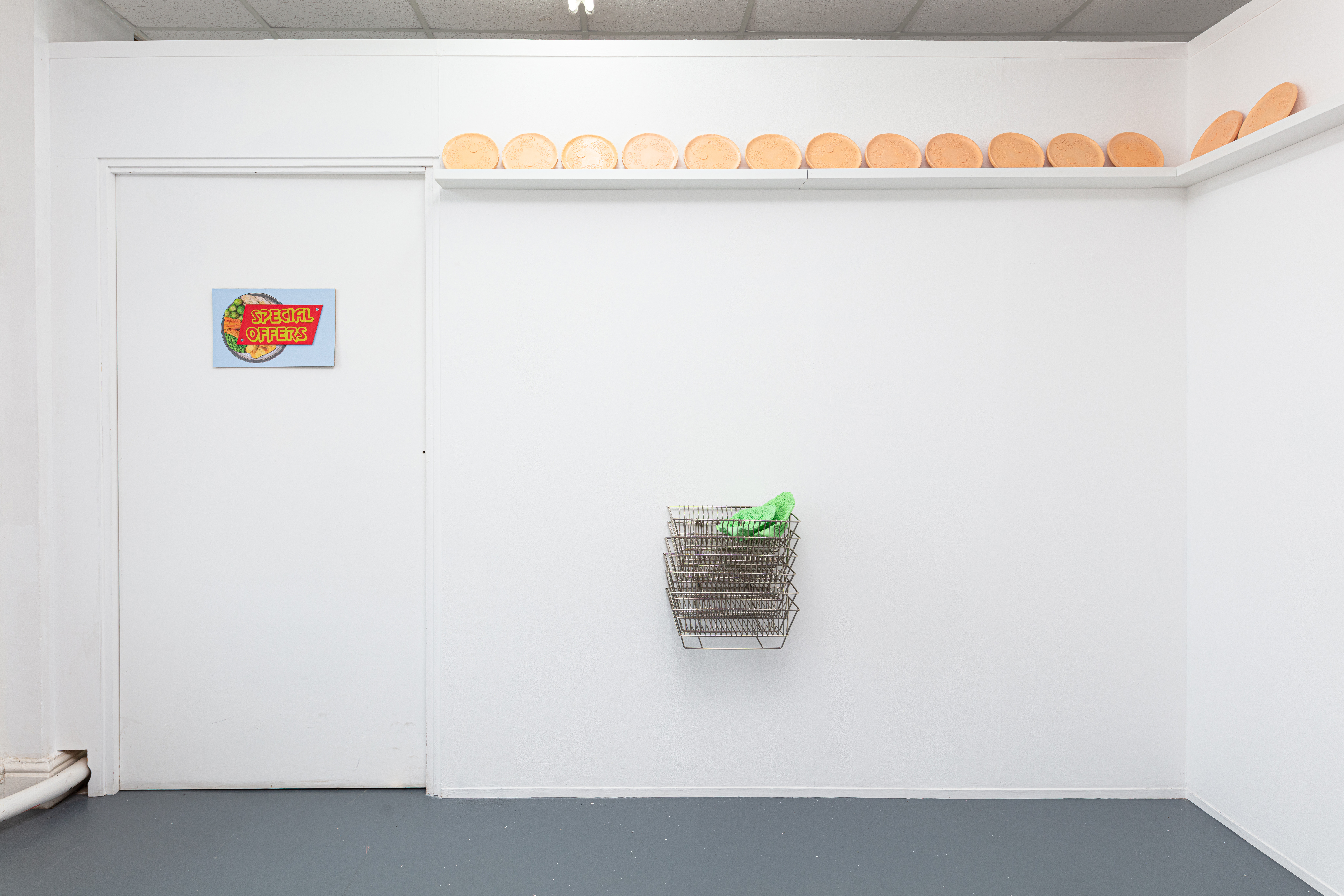
Here/There, installation view, Abingdon Studios, Blackpool, 2022. Image by Matt J Wilkinson
Let's talk about the work you have produced for your exhibitions at Abingdon Studios and Bloc Projects. It stems from a residency in Blackpool, and it would be interesting to talk about the works themselves and what role you want the work to perform.
The work that I have made to be exhibited at Abingdon Studios and Bloc Projects came from a period of residence I did with Abingdon Studios in Blackpool on the Work/Leisure Residency back in 2020. The pieces were intended as a response to Blackpool as a location that contains a form of contradiction, between a space that facilitates leisure on mass and the work that goes into cultivating that experience for others. I approached the residency theme by focusing on a singular object that I felt could encapsulate that concept, but that also had strong visual connections to Blackpool as a location.
So I began with the plate as an object. I knew prior to the residency that I wanted to explore something roughly within or around that object, because I'd been holding onto some imagery I had of the souvenir rock plates. Which are basically just imitations of meals like fish and chips made out of rock, the sweet, and presented on paper plates to buy as confectionery and as souvenirs in promenade shops. I took that initial interest in the object alongside other underlying material interests in my practice and used the residency in Blackpool as a catalyst to produce a new body of work that could explore all the varied connotations and uses plates have. Like commemoration, souvenirs, used in service and also the unusual and unexpected adaptations that are made by others through their use as an object. Blackpool provided a lot of visual inspiration for the work, there's such a breadth of imagery within the location and plates of food feature heavily in the exterior marketing of Blackpool's cafe's.
The residency itself although heavily influenced by Blackpool had to be adapted because of Covid 19, and so my time spent making the work occurred in my studio in Sheffield. This prolonged period also led to new influences and ideas arising outside of the location of the residency. A connection began to be formed between two locations, so not only was there a duality in Work/Leisure as a statement of intent but also between two separate spaces. Which is where the title Here/There came from. The pieces kind of pose that play between multiple things contained in a singularity, of objecthood and of materiality. Each plate piece is produced in Jesmonite rather than ceramic and cast in multiple. Casting is a process I am familiar with and allows me to work on mass, creating collections, which is something I wanted to continue into this work. There's something in the work to be said about mass production, from the mass presence of souvenirs in Blackpool but also the commonality of plates and the fact that as an object they are naturally acquired and kept in collections. Whether that be in a museum's ceramic collection or simply in a cupboard in your house.
The material process of producing the work also let me explore the pieces as an object devoid of function. Had they been produced in ceramics they would in many cases, function as a plate. I also wanted to explore those design choices seen in ceramic plates, of ornate decoration that devoid the plate of use. So in the rock plates I created the raised texture of the sugar food replicas. The process of casting was important and specifically highlighted in those pieces, because had I produced each plate in ceramic then the replica food would have been moulded and applied individually to the surface of a clay plate body. Through casting the moulded food and the plate are one, achieved through the same singular pour of Jesmonite. The food then becomes the surface texture of a sculpture not an addition. I think that the work asks to be questioned and seen through multiple readings, around function as a basis, intended function, diversions from function and the removal of function and then to look at what occurs in the space around that.
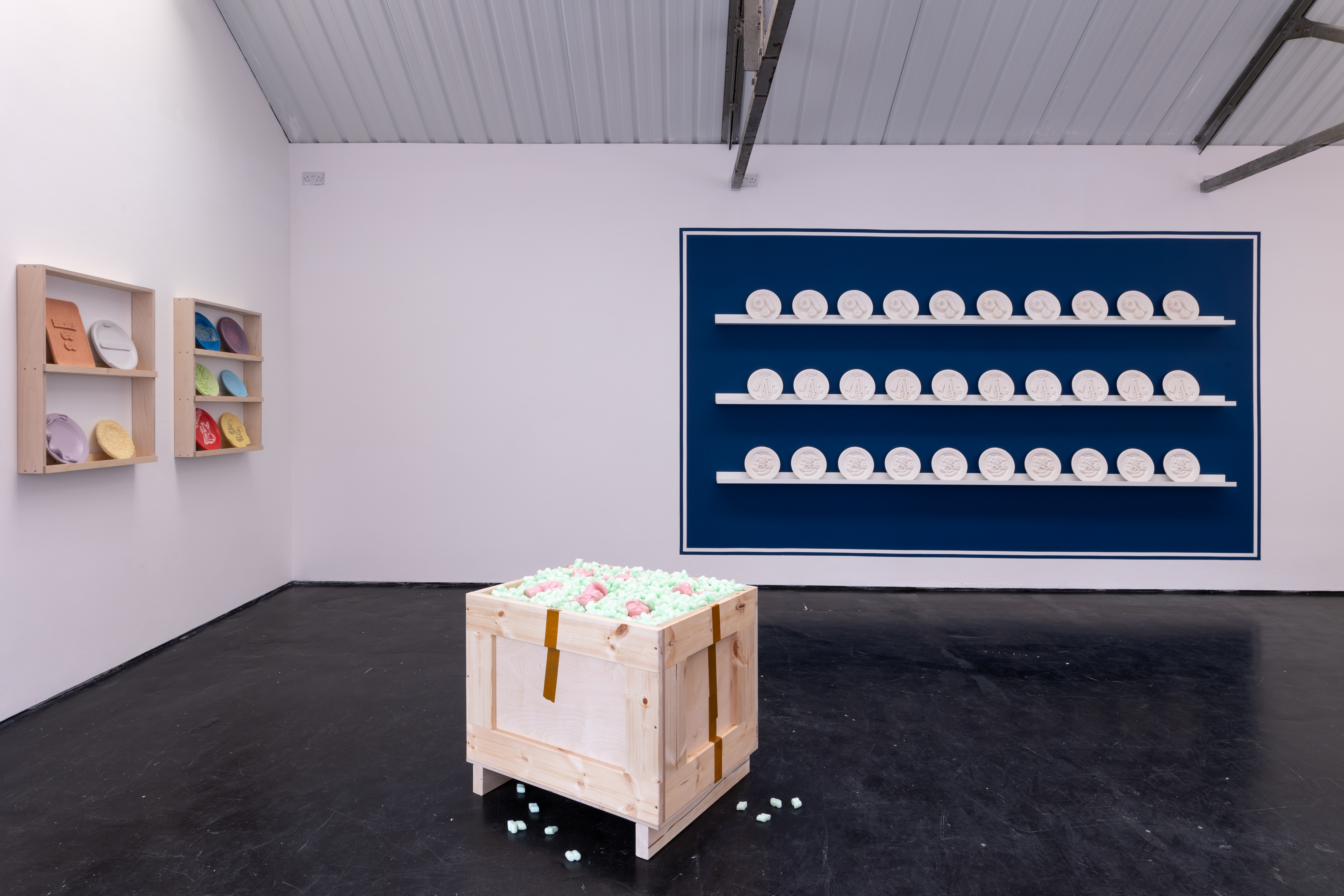
Here/There, installation view, Bloc Projects, Sheffield, 2022. Image by Peter Martin @ Shared Programme
With the work being presented at two different venues, one in Blackpool and one in Sheffield, I imagine there is a change of context that has to be considered when approaching the design and layout of the exhibition. Could you talk me through how you are approaching the exhibitions and if there are particularly similarities (aside from the work itself) and if there are distinctively different display methods that you will be using from gallery to gallery?
In a sense, the WORK/LEISURE residency kind of expanded into Here/There. I've had a lot of time between the commencement of the residency in 2020 and showing the work in 2022 and during that time, when I was working on the pieces, there was a lot of introspection into how I wanted to show the work. I think so much of the conversations during that time were focused on the future of exhibition making, especially in 2020, and lots of artists were thinking when that would be possible again. I wanted to make the most of the opportunity that I'd been given, to showcase the work that I'd produced and to also properly investigate the connections that had come out of that period.
Which is why this particular work is being shown in the way it is. In a sense it belongs in part to both spaces, and so there's an element of the unsettled in the work. Of belonging to neither location fully and of a sense of transition. The work has already been displayed in Blackpool at Abingdon Studios as we speak, in this exhibition I envisioned the driving force for the curatorial techniques and material choices to be led by an overarching context of labour, in relation to Blackpool. The shelves around the gallery walls were positioned at a height close to the ceiling, to tie in references of plate display methods you might find in traditional pubs. On these shelves I placed a variety of my pieces in groupings, including a large group of light orange plates with good luck tidings in various languages, and a cast two pence on their surface. The design of these plates takes inspiration from the 2p containers in the amusements by the seafront and their arrangement, a reference to the penny pusher machines. Apart from shelves on the walls, we used containers that are made for the cleaning of plates. As work was such a strong theme throughout the residency, I wanted to pay homage to that in the methods of display. There are household drying racks alongside industrial dishwasher trays on stand-alone shelving racks supported by castors. These look movable and all of the sculptures appear to be in some form of transition between arrival or removal, which isn't at any point defined. The plates on the dishwasher racks display food asking the question of whether they are waiting to be cleaned. However, they're cast in white, void of colour, so hold that imagery of a clean white plate. There are gaps in the displays on the shelves and the rest of the sculptures rest in stacks on the floor or are placed as if just set down.
When the work is exhibited at Bloc Projects there will be a very different approach to curating and very little of the display methods used in Blackpool will appear in this iteration. The most noticeable will be the lack of the dishwasher and drying racks. In Sheffield the labour of the pieces will be less of a reference to the various industries that utilise plates and more to the work that went into making the pieces. I aim to use the space in the gallery entrance to showcase the practical methods used throughout their production. In the exhibition itself the work will sit within units of display, designed to reference household cabinetry, but also transportation. Some of the pieces may appear settled and fill out display cases but these themselves will hold material connections to travel crates. The work will still be seen as being between a vision of arrival or departure. As the second exhibition, referencing this through display feels appropriate, as it also provides a context not only to the journey between the exhibitions but also to the context of the pieces. A return back to their location of production but also a collection of souvenirs from somewhere else.
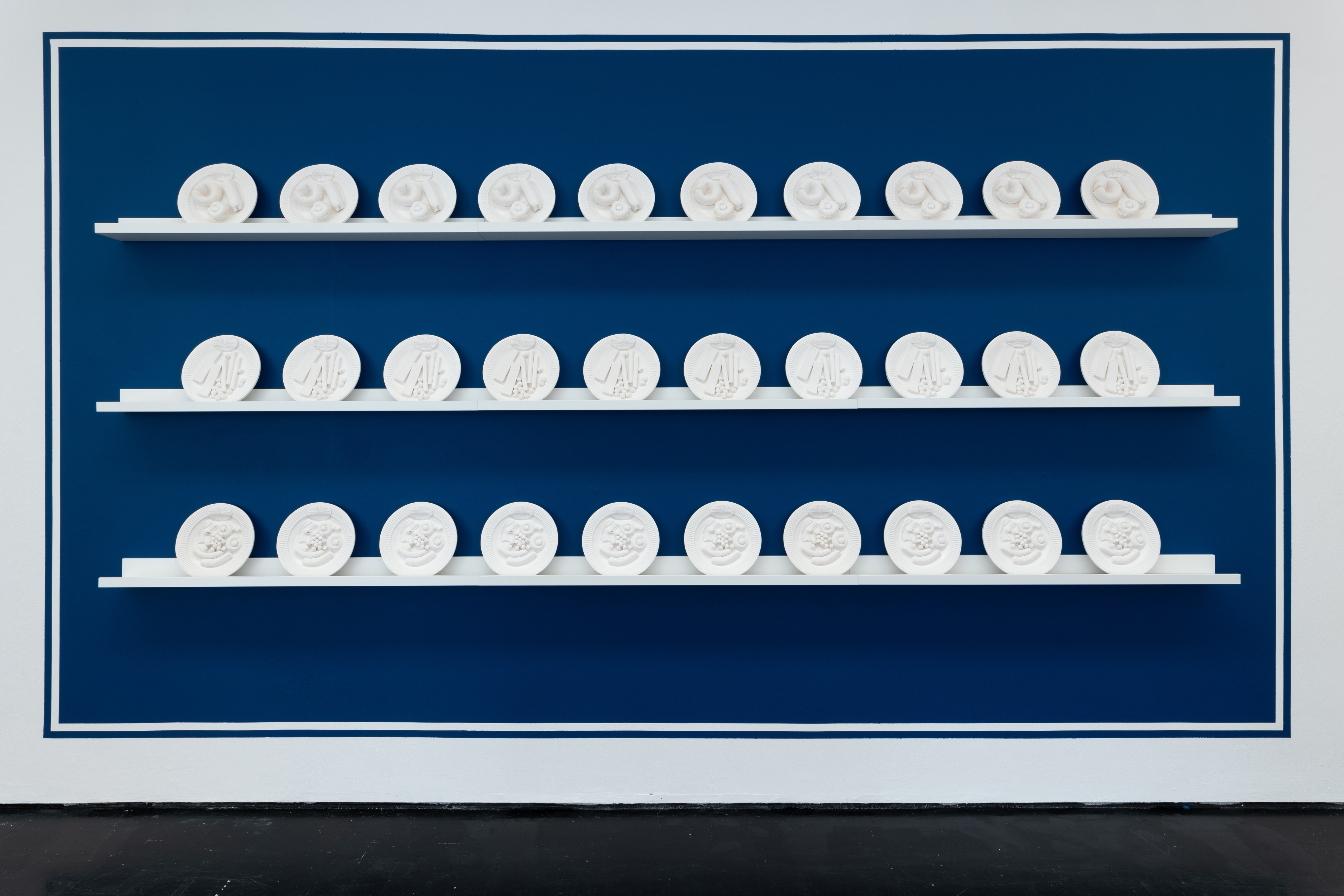 Here/There, installation view, Bloc Projects, Sheffield, 2022. Image by Peter Martin @ Shared Programme
Here/There, installation view, Bloc Projects, Sheffield, 2022. Image by Peter Martin @ Shared ProgrammeWhat do you have on the horizon?
At the moment I'm working on my second presentation of Here/There at Bloc Projects, which launches on Wednesday the 23rd of March and runs until the 2nd of April. After which I'll be working with Salt n Pepper Press to develop a publication documenting the entire project. I've also recently been chosen to take part in The Yorkshire Sculpture International's Sculpture Network, which I'm looking forward to engaging with over the coming months. I have another solo exhibition in Sunderland lined up for later in the year. Working with Daniel Goodman, Lucien Anderson and Harley Kuyck-Cohen, who I did my residency at Airspace with. Where I'm hoping to recontextualise some of my past work to produce an evolving display of sculpture. I have lots of other projects lined up in the wings too which I'm very excited about. It's been really great to have these two exhibitions to kick off my year and I'm really looking forward to what's to come!
-
charlotte-dawson.co.uk
-
If you like this why not read our interview with Benjamin Murphy.
-
© YAC | Young Artists in Conversation ALL RIGHTS RESERVED
